https://www.diyaudio.com/community/threads/killer-otls.316831/
Search on 12B4 OTL and a surprising # of threads come up. Is Everyone crazy?
Search on 12B4 OTL and a surprising # of threads come up. Is Everyone crazy?
Last edited:
No I don't think it's crazy at all, or if so, then I like crazy. I thought for sure you had built those - it's awesome that it was a commercial product.
What I meant was that the amount of work wiring together 60+ tubes just doesn't justify the results. The tubes are so small that the load overwhelms the parallel output Z to the extent that little remains of any triode "magic". N Fdbk is essential to get any semblance of linearity from this and many other OTL Amplifiers. Now, maybe with 3 to 5 times as many tubes in parallel. But that would only be practical with bigger tubes to reduce the # of sockets. If one is pushed to use big pentodes instead, then a more appropriate design would be one that emulates ( via special N Fdbk ) some quality triode model. Efficiency would improve as well ( at higher spec output only however. )Is Everyone crazy?
Last edited:
Reminds me of this crazy project. https://www.diyaudio.com/community/threads/100-watt-sweep-tube-circlotron-otl-wip.358700/
Thinking about what to drive with this design "concept" (loosely defined as the regulator in the driver position) - I'm probably getting the real advantage of the choice using it as a k-follower, for something BIG. Been looking through a bunch of AB2 designs - and output transformer demands led me pretty quickly to reading about parafeed and plate chokes. I have not done this, before, but it opens up a world of options, provided that it's actually easier to source the plate chokes cheaper than a OPT that can handle the current...
I also started thinking about simple single ended stuff with thoriated transmitter tubes - the things I've kinda thought of as "off limits" due to the $800+ investment in OPT's. I have tons of big chokes, just need to pick something that works and hunt for a second for the pair. If doing an AB2 build I would need 4, matching, which seems a little less do-able than 2...
So I've been reading whatever I can find on the requirements of a "good" plate choke - similar to single-ended output - air gapping, avoiding saturation. But these kinda data aren't advertised on chokes designed for use in a power supply. So, here's the question: am I misunderstanding that there is a fundamental difference? Let's say, UTC "S" series chokes, that wouldn't be appropriate? Needs to be an "audio" choke?? That could be just as difficult as finding the right OPT's, for say, ballpark ~1000V ~100mA (more like 4kV 300mA for the peaks, yes?). Especially finding a pair... I just wonder if anything I've got on the shelf would work, old UTC, Chicago, raytheon etc iron from military and ham equipment. I'm pretty sure I have a single plate choke that was on a single 807 in a small modulator amp... but that's not as big voltage or current as say, a gm70 or something like that... I would go 211 but they cost way too dang much. Thinking about the cheaper transmitter tubes including pentodes.
If power supply chokes are out of the question (are they?) then maybe I could find a couple plate chokes from a larger modulator? Would a unit like that be "hifi?"
I also, I started making a little collection of the junk I wanna sell, and I think I'll come up with more than $600 to spend on parts to complete this project. I see an awesome deal on the auction site for a 3/2.5/2k @300mA plate transformer, perfect for two gm70, or a tube in that general family. Preferably one with designs online for choke parafeed, and the gm70 is rich in that regard, so probably a good place to start for someone like me who is gonna need to stick pretty close to "known good" designs...
With what's left after that purchase, I could afford the "right" lundhal "ll1673" choke, brand new, AND the tubes, so, I'm really thinking gm70 might be the one... and without current restrictions, just voltage, in OPT's I have 6 steps between 5k and 10k to play with on the load.... in mono, anyways.
I also started thinking about simple single ended stuff with thoriated transmitter tubes - the things I've kinda thought of as "off limits" due to the $800+ investment in OPT's. I have tons of big chokes, just need to pick something that works and hunt for a second for the pair. If doing an AB2 build I would need 4, matching, which seems a little less do-able than 2...
So I've been reading whatever I can find on the requirements of a "good" plate choke - similar to single-ended output - air gapping, avoiding saturation. But these kinda data aren't advertised on chokes designed for use in a power supply. So, here's the question: am I misunderstanding that there is a fundamental difference? Let's say, UTC "S" series chokes, that wouldn't be appropriate? Needs to be an "audio" choke?? That could be just as difficult as finding the right OPT's, for say, ballpark ~1000V ~100mA (more like 4kV 300mA for the peaks, yes?). Especially finding a pair... I just wonder if anything I've got on the shelf would work, old UTC, Chicago, raytheon etc iron from military and ham equipment. I'm pretty sure I have a single plate choke that was on a single 807 in a small modulator amp... but that's not as big voltage or current as say, a gm70 or something like that... I would go 211 but they cost way too dang much. Thinking about the cheaper transmitter tubes including pentodes.
If power supply chokes are out of the question (are they?) then maybe I could find a couple plate chokes from a larger modulator? Would a unit like that be "hifi?"
I also, I started making a little collection of the junk I wanna sell, and I think I'll come up with more than $600 to spend on parts to complete this project. I see an awesome deal on the auction site for a 3/2.5/2k @300mA plate transformer, perfect for two gm70, or a tube in that general family. Preferably one with designs online for choke parafeed, and the gm70 is rich in that regard, so probably a good place to start for someone like me who is gonna need to stick pretty close to "known good" designs...
With what's left after that purchase, I could afford the "right" lundhal "ll1673" choke, brand new, AND the tubes, so, I'm really thinking gm70 might be the one... and without current restrictions, just voltage, in OPT's I have 6 steps between 5k and 10k to play with on the load.... in mono, anyways.
Last edited:
Oh I should also mention, for budgeting concerns - I have some 0.5mfd 2kV oil bath caps, used, ancient (50's) - but they should be good. I might need more farads, idk we will see. But potentially I don't have to spend on caps for the parafeed setup. Got all the other stuff, filament iron and such. Just need a HV plate transformer, the chokes, and the tubes. Should be easy at around $600...
Oh, well, I'll have to buy either a second OPT, or a pair if I settle on a load provided by a lower quality PA transformer (got a UTC varimatch with SE taps, very useful for breadboard)... but anyways... those wont be a million dollars if they dont need to carry the current, or even be gapped as i am reading....
Gm70 the current front-runner in my thinking, sketch of the circuit would be [amp section aiming for ~2.5 watts] -> [regulator as k-follower] -> [gm70 parafeed output].
Oh, well, I'll have to buy either a second OPT, or a pair if I settle on a load provided by a lower quality PA transformer (got a UTC varimatch with SE taps, very useful for breadboard)... but anyways... those wont be a million dollars if they dont need to carry the current, or even be gapped as i am reading....
Gm70 the current front-runner in my thinking, sketch of the circuit would be [amp section aiming for ~2.5 watts] -> [regulator as k-follower] -> [gm70 parafeed output].
Last edited:
I don't mess with HV xmit type tubes. All the rules of magnetic components are tilted against such endeavors and safety is almost non-existent. You need special test equipment, expensive heavy components, dangerous capacitors, just to get modest results, and mistakes are costly and can be deadly. To me such projects are about the visuals of big glowing tubes, and not much about sonics.
I would recommend starting with a proven, modest B+, P-P project and get something working well for low cost first. Some of the simple SE AMPs or a little more sophistication like the RCA SP10 P-P. Then if you are still interested in exotics, try UnSet or Tube Emulation schemes, which can get you amazing results with low cost tubes and components. They can be substituted into the above Amps easily to see comparative results.
Normal Pentode curves (6HJ5 )

6HJ5 with UnSet:

A $4 trioded tube for emulation:

Crazy Drive of 26LX6 :

Normal 26LX6 pentode curves:

6197 normal pentode curves (for driver stage)

Normal pentode curves for JJ KT77:

I would recommend starting with a proven, modest B+, P-P project and get something working well for low cost first. Some of the simple SE AMPs or a little more sophistication like the RCA SP10 P-P. Then if you are still interested in exotics, try UnSet or Tube Emulation schemes, which can get you amazing results with low cost tubes and components. They can be substituted into the above Amps easily to see comparative results.
Normal Pentode curves (6HJ5 )
6HJ5 with UnSet:
A $4 trioded tube for emulation:
Crazy Drive of 26LX6 :
Normal 26LX6 pentode curves:
6197 normal pentode curves (for driver stage)
Normal pentode curves for JJ KT77:
Last edited:
That's very prudent advice, but have no fear for my safety - if I was gonna die from this kinda stuff I'd be dead already. I'm actually pretty risk-averse. I have the one-hand rule going like a white-glove chauffer just to discharge caps. I'm not gonna go poking around in something that's on, whether it's 200v or 2k. I take safety seriously.
I've finished 3 "unique circuit" builds... I wouldn't say "self-designed" amps cause the individual building blocks are very simple, I'm just a smidgen outside of the box. It's about as original as lemon juice in the laundry. Everyone knows that trick! You get the baking sody and the lemon juice...
And I've fixed (restored) a heap of amps, and hold onto some. Never pairs, of course... not into that kinda money. But I've got like, an IPC 6L6 pp amp around to listen to... I really like this weird unlabeled 6b5 amp from about 1940... looks like a generic prototype... I've fixed heathkits and eicos and Harmon kardons and phillips... oh, there's a 45 pp that I lifted from a "top of the line" Atwater Kent radio that is very nice. All I did was to substitute the speaker field coil for a choke, and re-cap internally, to use it outside the radio... radio is in perfect condition, speaker cone good, I plan on returning the amp one day but... it sounds good though! And the radio don't pick up nuthin!
I deride myself as incompetent when it comes to designing circuits and describe myself as dense, but I'm comparing myself to the top few percent of people who post on this and other forums. I am comparing myself to actual engineers. I am nowhere close. But really, though, I can do this...
But I don't have a curve tracer, or an oscilloscope. I do have a measurement mic, mostly for crossover design. And I've collected a buncha junk hammy gear and military com equipment to pick over...
I may not need to build high power, because my speaker efficiency is so high I'm listening on 1~2 watts. I can drive myself out of the room with a 45 tube.
It's just for the sake of the fun involved. And, I can explore lower efficiency drivers if I do it..... naaah just kidding! Haha no way.
I'll figure it out, this isn't gonna be a complete build thread, I will almost definitely get bogged down by work before the end and finish it a year from now. I'm just kinda sketching. There's about the same chance of me driving a gm70 A2 output as there is an 815 AB2. I'll go back to reading... just, you know, daydreaming about amps... BIG ones...
Oh but, P.S. - I'm still not certain about the plate choke thing, despite more searching. Can I use something like a UTC S-33 (20H, 300mA max, 4kV max, 90 ohm) on the plate? Thinking about a gm70, but comparable voltage and current to a 211 or 845... or... do I need a gapped audio choke...? I just see a couple threads where people appear to be using typical hammond power-supply chokes for parafeed plate loading. Is that a thing...?
I've finished 3 "unique circuit" builds... I wouldn't say "self-designed" amps cause the individual building blocks are very simple, I'm just a smidgen outside of the box. It's about as original as lemon juice in the laundry. Everyone knows that trick! You get the baking sody and the lemon juice...
And I've fixed (restored) a heap of amps, and hold onto some. Never pairs, of course... not into that kinda money. But I've got like, an IPC 6L6 pp amp around to listen to... I really like this weird unlabeled 6b5 amp from about 1940... looks like a generic prototype... I've fixed heathkits and eicos and Harmon kardons and phillips... oh, there's a 45 pp that I lifted from a "top of the line" Atwater Kent radio that is very nice. All I did was to substitute the speaker field coil for a choke, and re-cap internally, to use it outside the radio... radio is in perfect condition, speaker cone good, I plan on returning the amp one day but... it sounds good though! And the radio don't pick up nuthin!
I deride myself as incompetent when it comes to designing circuits and describe myself as dense, but I'm comparing myself to the top few percent of people who post on this and other forums. I am comparing myself to actual engineers. I am nowhere close. But really, though, I can do this...
But I don't have a curve tracer, or an oscilloscope. I do have a measurement mic, mostly for crossover design. And I've collected a buncha junk hammy gear and military com equipment to pick over...
I may not need to build high power, because my speaker efficiency is so high I'm listening on 1~2 watts. I can drive myself out of the room with a 45 tube.
It's just for the sake of the fun involved. And, I can explore lower efficiency drivers if I do it..... naaah just kidding! Haha no way.
I'll figure it out, this isn't gonna be a complete build thread, I will almost definitely get bogged down by work before the end and finish it a year from now. I'm just kinda sketching. There's about the same chance of me driving a gm70 A2 output as there is an 815 AB2. I'll go back to reading... just, you know, daydreaming about amps... BIG ones...
Oh but, P.S. - I'm still not certain about the plate choke thing, despite more searching. Can I use something like a UTC S-33 (20H, 300mA max, 4kV max, 90 ohm) on the plate? Thinking about a gm70, but comparable voltage and current to a 211 or 845... or... do I need a gapped audio choke...? I just see a couple threads where people appear to be using typical hammond power-supply chokes for parafeed plate loading. Is that a thing...?
Last edited:
Simplest way I think would be to measure the self resonant frequency. You need a variable audio oscillator and an O'scope or a meter that works up to HF though, and a series resistor. The distributed capacitance is nulling out the inductance there, so useful freq. range is maybe 85% of that. Maybe someone knows of another easier method? Easy to run a square wave into it and observe the ringing freq. on the edges, but need an O'scope again. Would be a good idea to find the losses up near there too (mainly steel lamination losses ). Pulse it or square waves thru a high value resistor, and see how long it rings.
Last edited:
Were those originally intended for audio use?True, but the 6GF5 brings 770V B+ or 160 mA capabilities in a smallish bottle that almost "looks" like a driver. Just perfect for those exotic tough to drive output cases like HV transmitter tubes or class B2 tubes. For a (strange) OTL like below, 30 12B4s might have been replaced by just 6 6GF5s. (would need to check Watts, but rail V's could be lower with the 6GF5 )
( 6GF5s were on the famous $1 list for a long while.)
View attachment 1316376
Were those originally intended for audio use?
The datasheet says H Deflection use in TVs (small ones).
Seeing as it seems to be a cut down 6GE5 (to fit a smaller bottle) and the 6GE5 is directly related to the 6JN6, which sold out for audio use (P Millett's "Engineer's Amplifier" ), it's probably OK. Certainly looking good with "UnSet".
GE 6GF5 B pentode:
Sylvania B pentode 6GF5:
As stated, the 6GF5 was a Horizontal Sweep tube intended for small TV sets. The 6GE5 is the same tube with larger plate wings in a bigger bottle to house them. The 6JN6, 6JM6 and a few others are all just 6DQ6B tube guts stuffed into different bottles with whatever pinout and base a large TV set maker asked for. Many of the tubes we see today are repackaged oldies from previous years. Some Google searching reveals that the 6GF5 was used in some Tektronix 500 series scopes. I know from my experience in the cal lab at Motorola that the Tek 504 scope used a 6DQ6 in the vacuum tube based SMPS, so a shrunken 6DQ6 in a newer scope seems reasonable. As with most sweep tubes, use in class AB1 push pull audio amps is a given with good results. Use of horizontal sweep tubes in a class A SE amp is hit or miss since the linear region is usually quite close to the red plate zone in class A. The little 6GF5 would only be good for a few watts in class A SE.
Simplest way I think would be to measure the self resonant frequency. You need a variable audio oscillator and an O'scope or a meter that works up to HF though, and a series resistor. The distributed capacitance is nulling out the inductance there, so useful freq. range is maybe 85% of that. Maybe someone knows of another easier method? Easy to run a square wave into it and observe the ringing freq. on the edges, but need an O'scope again. Would be a good idea to find the losses up near there too (mainly steel lamination losses ). Pulse it or square waves thru a high value resistor, and see how long it rings.
Wow, awesome, I wish I could find an explanation like this for every question I have - with words & verbs rather than math & the passive voice of a lab report. Very helpful!
I should really get an oscilloscope...
But also I should probably not stray far from the trodden path, and reading through this thread:
https://www.diyaudio.com/community/...ments-for-output-tube-from-the-driver.393614/
...I really see so much of myself in the OP, who is going after a gm70 build without a real comprehension of the circuit. Your warnings & Lauscher's & KevinKR's are definitely the voices of reason I should be listening to. Just because I haven't made a mistake yet, don't mean I won't. But I probably won't... however I'm particularly afraid of ruining transformers while screwing around. That's almost worse than death! This quote:
"[The gm70] is also quite short lived, I am about to install my 13th pair in 13 years of operation sometime in the next couple of months. Running them beyond 1200 - 1400 hours is risky due to the possibility of destructive runaway if one of the filaments breaks, and they will.. (This will probably destroy your output transformer before you have had time to react.)"
...that alone really puts me off it, the gm70. I like a design that is built to last, and I am not gonna stock 20 pairs of a tube just to be able to melt-down a coil one day.
I'll just keep on reading and see where I end up.
Also, as you point out, it's really all about the curves, and it's not like I have hangups about aesthetics, or aesthetic goals. I'll rack-mount the amps and cage the back, I won't even be looking directly at the tubes... looks, or the "cool-factor" of a bright thoriated tube really doesn't matter to me one bit...
So yep, back to just exploring options. I should probably have 20+ scratch built amps under my belt before turning to 1kV+ units. You said it, I ignored it, but then it settled in & I'm on board now...
About 23 years ago I caught the SE fever. First it led me to build a small SE amp with 45 tubes (they could still be found for under $10 each). Then I stuffed 2A3's in it followed by 300B's and it eventually evolved into the original Tubelab TSE and now TSE-II. I found a schematic for "The poor man's Ongaku" a 211 SE amp on the web somewhere and build one on a prototyping system that I called the "Tubelab." It sucked, so I redesigned it by replacing the entire driver section with a PC board design I had been working on that would become the TSE. It ran on 1050 volts, made 30 WPC, but dumped about 500 watts of excess heat into my 100 square foot room, which limited my listening time to an hour or two as I lived in south Florida. Eventually it saw no use at all and wound up sold at the Dayton Hamfest just over a year ago. By this time, I had found far simpler means of making 30+ watts of SE goodness, and I now have a 2000 square foot basement 1200 miles North of Florida. I sold most of the 845 and 211 tubes too. So far nobody has shown an interest in the Death Amp 2000 parts that I have dragged to the hamfest several times. The monster that I was playing in my avatar picture is a single channel SE amp that used an 833A transmitting tube on 1500 volts. Power output was about 200 watts through a custom one off Transcendar OPT. Pictures from 2003. I don't need or want a huge SE guitar amp, but if I ever run out of projects.........
The picture shows the two-chassis amp and power supply combo. The amp chassis used one of the two DIY PC boards that became the TSE. Note the 2004 copyright date and the first use of the Tubelab name. This amp started out on the Tubelab Breadboard and prototyping system. Yes, I was stupid enough to run 900 volts through Radio Shack clip leads.
The modern design, vintage....last month, uses a $1 tube augmented with a pair of mosfets to make 50 to 100 volts RMS of drive (yes, it will drive a truck!). Seen here in prototype stage driving a pair of 26HU5 TV sweep tubes wired in parallel UNSET to 35 watts at 1.23% THD on just over 500 volts. Still tweaking on it, but If I had to build a big SE amp now, this would be it! The driver board can use one of about 15 different cheap tubes. Drives a fat transmitter tube to 30 watts too, but it (the 4D32 tube) wasn't too happy about it.
The picture shows the two-chassis amp and power supply combo. The amp chassis used one of the two DIY PC boards that became the TSE. Note the 2004 copyright date and the first use of the Tubelab name. This amp started out on the Tubelab Breadboard and prototyping system. Yes, I was stupid enough to run 900 volts through Radio Shack clip leads.
The modern design, vintage....last month, uses a $1 tube augmented with a pair of mosfets to make 50 to 100 volts RMS of drive (yes, it will drive a truck!). Seen here in prototype stage driving a pair of 26HU5 TV sweep tubes wired in parallel UNSET to 35 watts at 1.23% THD on just over 500 volts. Still tweaking on it, but If I had to build a big SE amp now, this would be it! The driver board can use one of about 15 different cheap tubes. Drives a fat transmitter tube to 30 watts too, but it (the 4D32 tube) wasn't too happy about it.
Attachments
-
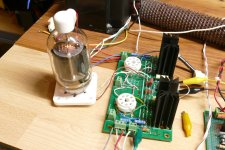 P4020545.JPG450.6 KB · Views: 65
P4020545.JPG450.6 KB · Views: 65 -
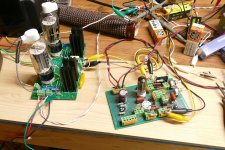 P4020539.JPG529.2 KB · Views: 55
P4020539.JPG529.2 KB · Views: 55 -
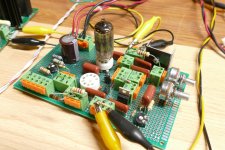 P4020533.JPG421 KB · Views: 57
P4020533.JPG421 KB · Views: 57 -
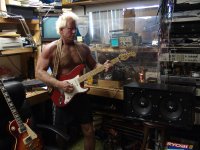 DSC01794.JPG530.9 KB · Views: 51
DSC01794.JPG530.9 KB · Views: 51 -
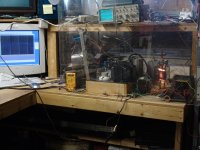 DSC01712.JPG515.9 KB · Views: 62
DSC01712.JPG515.9 KB · Views: 62 -
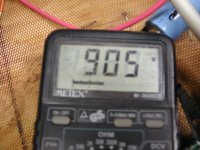 DSCN4858.JPG654.7 KB · Views: 63
DSCN4858.JPG654.7 KB · Views: 63 -
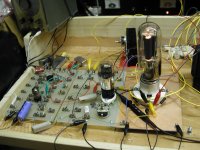 DSCN4851.JPG757.8 KB · Views: 56
DSCN4851.JPG757.8 KB · Views: 56 -
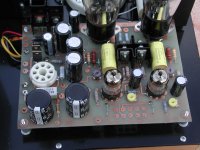 DSCN6851.JPG716.2 KB · Views: 50
DSCN6851.JPG716.2 KB · Views: 50 -
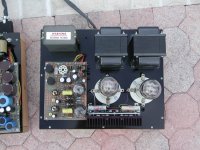 DSCN6821.JPG851.4 KB · Views: 64
DSCN6821.JPG851.4 KB · Views: 64 -
 BothChassis.jpg920.5 KB · Views: 66
BothChassis.jpg920.5 KB · Views: 66 -
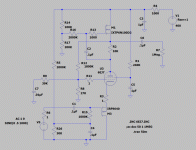 Unseturator 5-12-24.gif670.4 KB · Views: 65
Unseturator 5-12-24.gif670.4 KB · Views: 65
George, what OT are you using with your latest parallel 26HU5 UnSet?
I've got an old style Hammond 1640SE 1250 Ohm that could use some parallel driving. I've got 26HU5's and 6528's sitting on the shelf. Those are the biggest tubes I have. Still fit an Octal socket. Sounds like you must be getting some reasonable efficiency for SE using UnSET.
I've got an old style Hammond 1640SE 1250 Ohm that could use some parallel driving. I've got 26HU5's and 6528's sitting on the shelf. Those are the biggest tubes I have. Still fit an Octal socket. Sounds like you must be getting some reasonable efficiency for SE using UnSET.
The large black lump in the upper left corner of the first picture is a 5000 ohm Hammond 1628SEA from 2006. Aside from the 1628SEs that AES sent me by "mistake" when I ordered these, the 1628SEAs are the lossiest OPT's that I ever tested. They consistently eat up 10% more power than the large 5K ohm Edcors in every test where identical test conditions were used (5000 to 8 ohms). The 5000 ohm Edcors only have a single 8 ohm secondary. In this and most of my recent tests I am running the Hammonds as a 2500 ohm OPT with my 8 ohm load on the 16 ohm tap. In most of my earlier lower powered SE experiments the Edcors seem to sound better than the Hammonds, and the smaller Transcendars that I had beat them both, which is why the 1628SEAs have never been mounted. As you have demonstrated with your curve tracer, UNSET can make some pretty nice triodes out of TV sweep tubes. UNSET on a big fat one like the 6LW6 or 26HU5 drives the OPT with a low impedance source, which works like a low valued resistor across the parasitic resonances in the OPT, lowering the "Q" of its resonance and flattening out the response at both ends of the frequency range. When I get a chance to make a complete amp, I will likely use a pair of 26HU5s in UNSET per channel as the octal sockets are easier to mount than the 4D32 sockets, and the 4D32s would look better when displayed in a badass guitar amp. Thoriated filament tubes don't like mishandling so the few 833s, 211s and 845s I have left still sit on the shelf.
I measured some info for the Hammond 1640SE 1250 Ohm OT here:
at 54V 60 Hz excitation, Lpri = 27.646 Henry
Rpri DC = 84 Ohms
so 84/1250 = 6.7 % loss (not including the secondary loss )
8 Ohm sec has 0.7 Ohm and 1.0 Ohm (DC) windings in parallrl, for 0.411 Ohm sec for 8 Ohm, so another 5.1% loss in sec.
the new 1640SEA has 14 Hy listed here:
https://www.hammfg.com/electronics/transformers/audio/1627-1642?referer=968
So looks like the new version has .7x the turns, and probably 1.4x the wire area, so I guestimate 42 Ohms DC
So maybe I could use the 1640SE as a 2500 OT with the 4 Ohm secondary used as 8 Ohm. Voltage ratings stay the same however, so AC Watts reduce to 0.707 x 25 W = 17.6 Watt then
at 54V 60 Hz excitation, Lpri = 27.646 Henry
Rpri DC = 84 Ohms
so 84/1250 = 6.7 % loss (not including the secondary loss )
8 Ohm sec has 0.7 Ohm and 1.0 Ohm (DC) windings in parallrl, for 0.411 Ohm sec for 8 Ohm, so another 5.1% loss in sec.
the new 1640SEA has 14 Hy listed here:
https://www.hammfg.com/electronics/transformers/audio/1627-1642?referer=968
So looks like the new version has .7x the turns, and probably 1.4x the wire area, so I guestimate 42 Ohms DC
So maybe I could use the 1640SE as a 2500 OT with the 4 Ohm secondary used as 8 Ohm. Voltage ratings stay the same however, so AC Watts reduce to 0.707 x 25 W = 17.6 Watt then
Last edited:
Oops, I calculated the secondary Ohms for the 4 Ohm wiring, not the 8 Ohm wiring. So that would be more like 10.2% loss in secondary. For 16.9% total loss. Can that be right? Usually the secondary is sized for equal copper loss as the primary.
I don't have the old wiring diagram in front of me. So Flying blind.
I don't have the old wiring diagram in front of me. So Flying blind.
Last edited:
I've measured the frequency response of the Hammond 1640SE and it looks flat from 30 Hz to 30 KHz per spec, with either 4 or 8 Ohm load on the paralleled 4 Ohm sec. windings. No valleys until 33 KHz. 8 Ohm loading gives a somewhat higher output V level as you would expect.
Looking at tubes for it: 26HU5, 26LX6, 26LW6 they all are around 286 Ohms Zout at 125 mA. ( I likely would use UnSET configured for a mu near the inherent mu of about 4 ) The OT is rated for 200 mA DC. Typical DC Imax for the OT would use up half the magnetic flux. So Lpri would drop to half of 27.646 Hy, or 14 Hy. giving XL = 2 pi 30Hz 14Hy = 2639 Ohm for XL, about 9.2 times the tube Zout. Probably OK, but the air gap spacer could be thinned a little for 125 mA DC. 8 Ohms on the 4 Ohm nominal secondary would similarly give 2500 Ohms loading at the primary.
The 6528 V reg. tube ( 30W + 30W, triode, mu 9, gm 37000 per sect. ) gives 245 Ohms Zout (per section ) so looks good too. I probably would use a tube emulation driver for it to get super triode curves, but the mu 9 might leave some room to try UnSet also.
------------------------------------------------------------
Seeing how the 200 mA Imax DC rating (when DC is present ) would bring the primary inductance down to the 14 Hy rating of the newer Hammond 1640SEA, what Inductance configuration does Hammond quote for these SE OTs? I'll bet that most home L measurements don't take DC current effects into account.
Looking at tubes for it: 26HU5, 26LX6, 26LW6 they all are around 286 Ohms Zout at 125 mA. ( I likely would use UnSET configured for a mu near the inherent mu of about 4 ) The OT is rated for 200 mA DC. Typical DC Imax for the OT would use up half the magnetic flux. So Lpri would drop to half of 27.646 Hy, or 14 Hy. giving XL = 2 pi 30Hz 14Hy = 2639 Ohm for XL, about 9.2 times the tube Zout. Probably OK, but the air gap spacer could be thinned a little for 125 mA DC. 8 Ohms on the 4 Ohm nominal secondary would similarly give 2500 Ohms loading at the primary.
The 6528 V reg. tube ( 30W + 30W, triode, mu 9, gm 37000 per sect. ) gives 245 Ohms Zout (per section ) so looks good too. I probably would use a tube emulation driver for it to get super triode curves, but the mu 9 might leave some room to try UnSet also.
------------------------------------------------------------
Seeing how the 200 mA Imax DC rating (when DC is present ) would bring the primary inductance down to the 14 Hy rating of the newer Hammond 1640SEA, what Inductance configuration does Hammond quote for these SE OTs? I'll bet that most home L measurements don't take DC current effects into account.
Last edited:
I also just measured the 1640SE OT with an 8 Ohm load on the full-up 8 Ohm configured secondary, and the response -begins- to visibly fall off at 20 KHz now. But, no valleys below 20 KHz still.
So this 1640SE OT will work better as a 2500 Ohm Zpri OT.
I wonder how well the 2500 Ohm 1627SE or SEA OT perform in comparison. The 1627SEA lists 20 Hys Lpri, which would be the expected L with Imax DC applied. And 160 mA Imax DC. While the 1640SE, with 200 mA Imax DC applied would be expected as 14 Hys. ( 28 Hys without the DC applied)
That's probably giving me a clue to how much to thin the air gap spacer on mine for the lower current planned. (so thin the gap till 40 Hys without the DC, instead of the 27 Hys presently measured without DC)
So this 1640SE OT will work better as a 2500 Ohm Zpri OT.
I wonder how well the 2500 Ohm 1627SE or SEA OT perform in comparison. The 1627SEA lists 20 Hys Lpri, which would be the expected L with Imax DC applied. And 160 mA Imax DC. While the 1640SE, with 200 mA Imax DC applied would be expected as 14 Hys. ( 28 Hys without the DC applied)
That's probably giving me a clue to how much to thin the air gap spacer on mine for the lower current planned. (so thin the gap till 40 Hys without the DC, instead of the 27 Hys presently measured without DC)
Last edited:
- Home
- Amplifiers
- Tubes / Valves
- Scratching my Brain trying to remember a tube type...